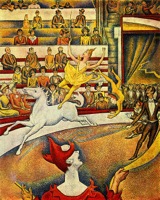Difference between revisions of "Circus"
m (Text replacement - "http://" to "https://") |
|||
| Line 2: | Line 2: | ||
==Origin== | ==Origin== | ||
| − | ''Circus'' derives from [[Latin]] "''circus''", which is the romanization of the [[Greek]] "κίρκος" (''kirkos''), itself a [ | + | ''Circus'' derives from [[Latin]] "''circus''", which is the romanization of the [[Greek]] "κίρκος" (''kirkos''), itself a [https://en.wikipedia.org/wiki/Metathesis_(linguistics) metathesis] of the [https://en.wikipedia.org/wiki/Homeric_Greek Homeric Greek] "κρίκος" (''krikos''), meaning "[[circle]]" or "ring". |
| − | *[ | + | *[https://en.wikipedia.org/wiki/14th_century 14th Century] |
==Definitions== | ==Definitions== | ||
*1a : a large arena enclosed by tiers of seats on [[three]] or all four sides and used especially for [[sports]] or [[spectacles]] (as [[athletic]] [[contests]], exhibitions of horsemanship, or in [[ancient]] times chariot racing) | *1a : a large arena enclosed by tiers of seats on [[three]] or all four sides and used especially for [[sports]] or [[spectacles]] (as [[athletic]] [[contests]], exhibitions of horsemanship, or in [[ancient]] times chariot racing) | ||
:b : a [[public]] [[spectacle]] | :b : a [[public]] [[spectacle]] | ||
| − | *2a : an arena often covered by a [ | + | *2a : an arena often covered by a [https://en.wikipedia.org/wiki/Tent tent] and used for variety shows usually including feats of [[physical]] [[skill]], wild [[animal]] acts, and [[performances]] by [[clowns]] |
:b : a circus [[performance]] | :b : a circus [[performance]] | ||
:c : the [[physical]] plant, livestock, and personnel of such a circus | :c : the [[physical]] plant, livestock, and personnel of such a circus | ||
| Line 14: | Line 14: | ||
:b British : a usually [[circular]] area at an [[intersection]] of streets | :b British : a usually [[circular]] area at an [[intersection]] of streets | ||
==Description== | ==Description== | ||
| − | A '''circus''' is commonly a [[traveling]] company of [[performers]] that may include [[clowns]], [ | + | A '''circus''' is commonly a [[traveling]] company of [[performers]] that may include [[clowns]], [https://en.wikipedia.org/wiki/Acrobatics acrobats], [[trained]] animals, [https://en.wikipedia.org/wiki/Trapeze trapeze acts], musicians, hoopers, [https://en.wikipedia.org/wiki/Tightrope_walker tightrope walkers], [[jugglers]], [https://en.wikipedia.org/wiki/Unicycle unicyclists] and other stunt-oriented artists. The [[word]] also describes the [[performance]] that they give, which is usually a [[series]] of acts that are told how to play [[music]] and introduced by a "[https://en.wikipedia.org/wiki/Ringmaster_(circus) ringmaster]". A traditional circus performance is normally held in a ring 13m (42ft) in [[diameter]]. This [[dimension]] was adopted by [https://en.wikipedia.org/wiki/Philip_Astley Philip Astley] to enable a horse rider to stand upright on a cantering horse to perform a series of acrobatic manoeuvres and to more easily retain their [[balance]]. Most [[modern]] circuses have a system of tiered seating around the ring for the [[public]] and since the late 19th early 20th century the [[performance]] has taken place under canvas and more recently plastic tents commonly called "The Big Top" .[https://en.wikipedia.org/wiki/Circus] |
[[Category: General Reference]] | [[Category: General Reference]] | ||
Latest revision as of 23:40, 12 December 2020
Origin
Circus derives from Latin "circus", which is the romanization of the Greek "κίρκος" (kirkos), itself a metathesis of the Homeric Greek "κρίκος" (krikos), meaning "circle" or "ring".
Definitions
- 1a : a large arena enclosed by tiers of seats on three or all four sides and used especially for sports or spectacles (as athletic contests, exhibitions of horsemanship, or in ancient times chariot racing)
- 2a : an arena often covered by a tent and used for variety shows usually including feats of physical skill, wild animal acts, and performances by clowns
- b : a circus performance
- c : the physical plant, livestock, and personnel of such a circus
- d : something suggestive of a circus (as in frenzied activity, sensationalism, theatricality, or razzle-dazzle) <a media circus>
- 3a obsolete : circle, ring
- b British : a usually circular area at an intersection of streets
Description
A circus is commonly a traveling company of performers that may include clowns, acrobats, trained animals, trapeze acts, musicians, hoopers, tightrope walkers, jugglers, unicyclists and other stunt-oriented artists. The word also describes the performance that they give, which is usually a series of acts that are told how to play music and introduced by a "ringmaster". A traditional circus performance is normally held in a ring 13m (42ft) in diameter. This dimension was adopted by Philip Astley to enable a horse rider to stand upright on a cantering horse to perform a series of acrobatic manoeuvres and to more easily retain their balance. Most modern circuses have a system of tiered seating around the ring for the public and since the late 19th early 20th century the performance has taken place under canvas and more recently plastic tents commonly called "The Big Top" .[1]
